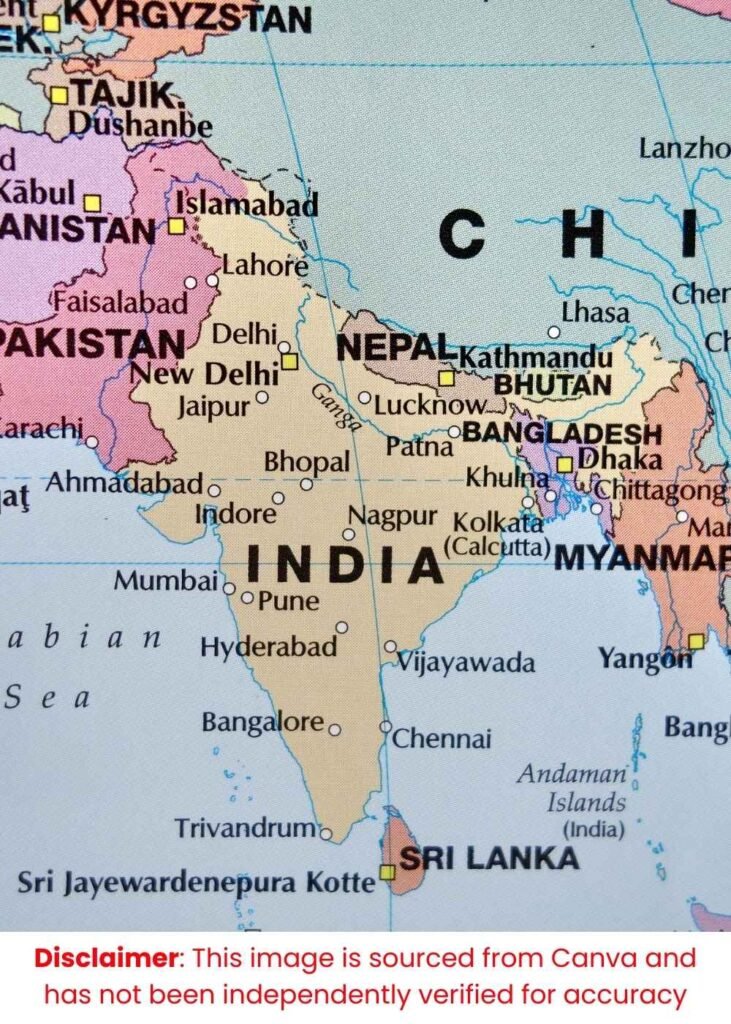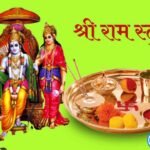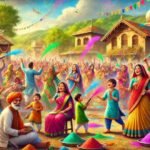India, a diverse country both culturally and geographically, is divided into 28 states and 8 Union Territories, each with unique cultural, historical, and political significance. A political map of India shows the boundaries and locations of these states and Union Territories. Here’s a description of India’s political map, emphasizing its structure, significance, and a brief overview of each region’s administrative details.
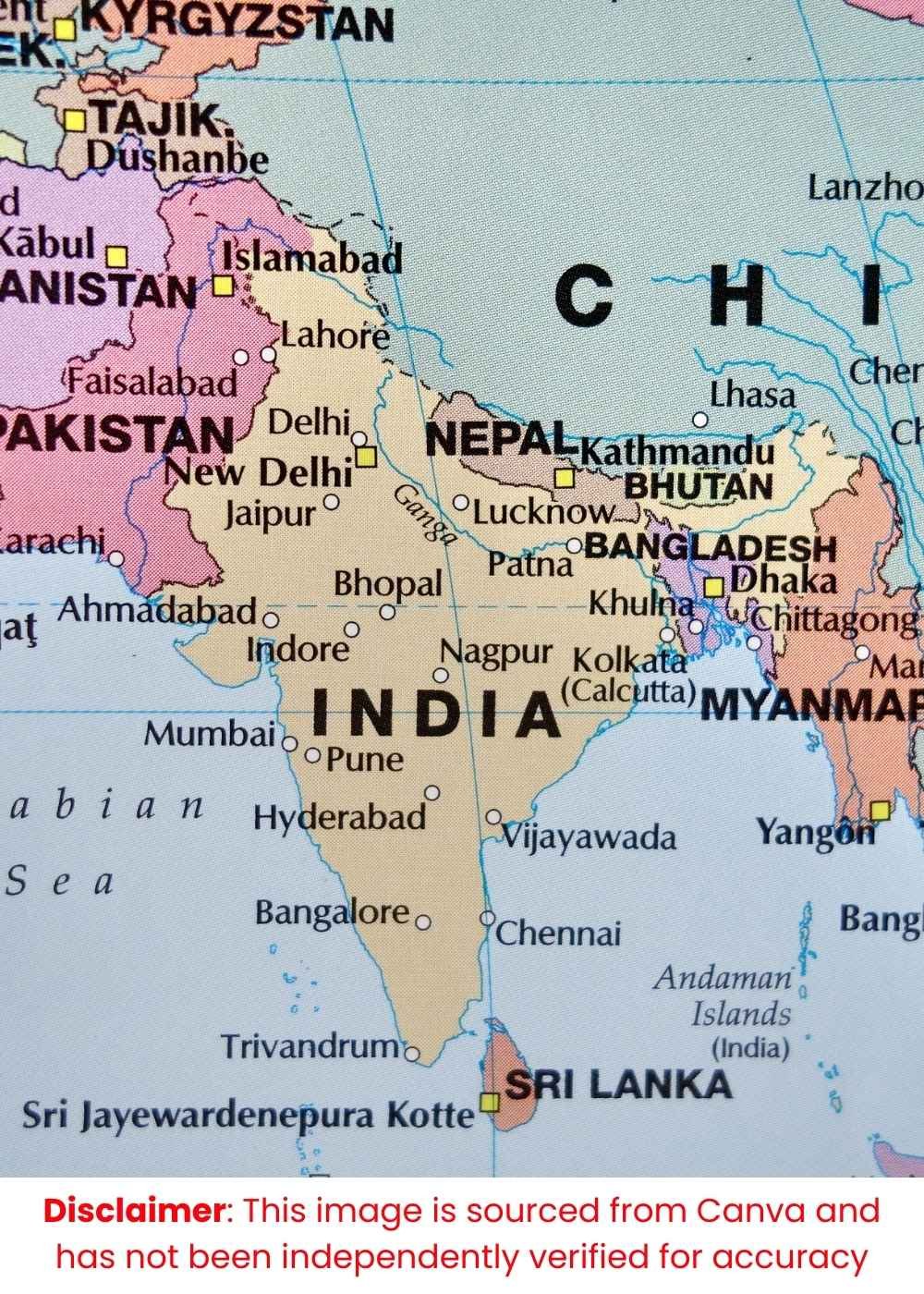
1. Northern India
- Jammu and Kashmir and Ladakh (Union Territories): Known for their stunning landscapes, these regions are located in the northernmost part of India. Post-2019, Jammu and Kashmir was reorganized as a Union Territory, while Ladakh also gained Union Territory status.
- Punjab: Located along the northwestern border, Punjab is a major agricultural hub, famous for its Sikh heritage and vibrant festivals.
- Haryana: Surrounding Delhi on three sides, Haryana is known for its agricultural production and as an industrial powerhouse.
- Himachal Pradesh: Known for its scenic beauty and hill stations, this state lies in the Western Himalayas.
- Uttarakhand: Also part of the Himalayan range, Uttarakhand is known for its religious sites, including Haridwar and Rishikesh.
2. Western India
- Rajasthan: India’s largest state by area, Rajasthan is known for its deserts, forts, and vibrant culture.
- Gujarat: Located on the western coast, Gujarat has a significant coastline along the Arabian Sea and is one of India’s most industrialized states.
- Maharashtra: India’s second-most populous state, Maharashtra houses Mumbai, the country’s financial capital.
3. Central India
- Madhya Pradesh: Known as the “Heart of India” due to its central location, Madhya Pradesh is rich in historical sites and wildlife reserves.
- Chhattisgarh: Formed in 2000, Chhattisgarh is known for its mineral resources and dense forests.
4. Eastern India
- Bihar: Bihar has a deep historical significance as it was the birthplace of Buddhism and Jainism.
- Jharkhand: Known for its rich mineral resources, Jharkhand was carved out of Bihar in 2000.
- West Bengal: Located along the eastern coast, West Bengal is known for its cultural heritage and major cities like Kolkata.
- Odisha: With a long coastline, Odisha is known for its ancient temples, tribal culture, and mineral wealth.
5. Southern India
- Andhra Pradesh: Known for its rich culture and coastal economy, Andhra Pradesh has the second-largest coastline among Indian states.
- Telangana: Created in 2014, Telangana is known for Hyderabad, a major tech and industrial hub.
- Tamil Nadu: Located at the southern tip, Tamil Nadu is known for its temples, rich culture, and the Chennai IT industry.
- Karnataka: This state houses Bengaluru, known as the “Silicon Valley of India,” and is also rich in heritage sites.
- Kerala: Known as “God’s Own Country,” Kerala is famous for its backwaters, spices, and high literacy rate.
6. Northeastern India
- Sikkim: India’s least populous state, Sikkim is known for its stunning Himalayan landscapes.
- Assam: Known for its tea plantations and Brahmaputra River, Assam is a key northeastern state.
- Arunachal Pradesh: This state shares international borders with Bhutan, China, and Myanmar and is known for its scenic beauty.
- Nagaland, Manipur, Mizoram, Tripura, and Meghalaya: These smaller northeastern states are culturally rich, with distinct tribal cultures and biodiversity.
Union Territories on the Political Map 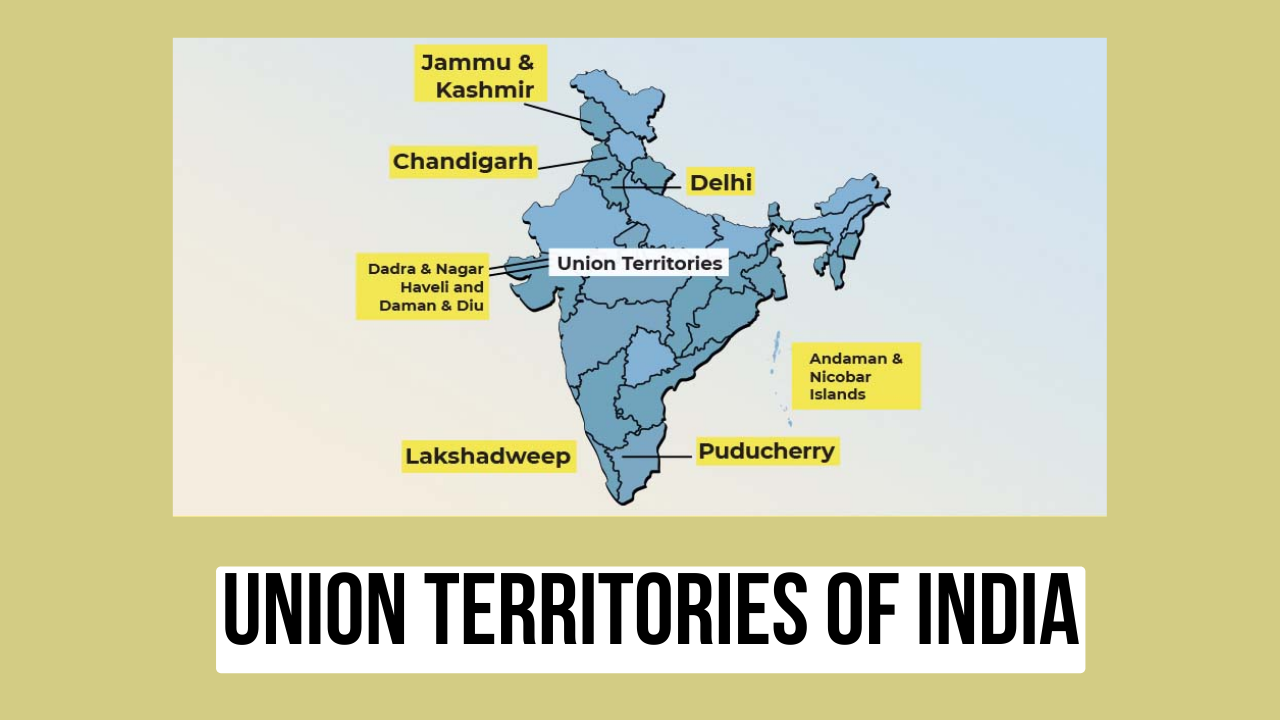
- Delhi (National Capital Territory): Located in northern India, Delhi serves as the capital of India and holds political significance.
- Andaman and Nicobar Islands: Located in the Bay of Bengal, this UT is known for its beautiful beaches and biodiversity.
- Lakshadweep: Located in the Arabian Sea, this UT is a group of islands known for coral reefs and marine life.
- Puducherry: Situated along the southeastern coast, Puducherry retains French colonial influence.
- Chandigarh: Serving as the capital of both Punjab and Haryana, Chandigarh is a planned city.
- Dadra and Nagar Haveli and Daman and Diu: Located along India’s western coast, these regions have Portuguese influences.
Importance of the Political Map of India

A political map of India provides insights into:
- Administrative Boundaries: The map outlines each state and UT’s boundaries, which is essential for governance, policy planning, and development.
- Cultural and Historical Insights: Each state and UT is unique in its cultural heritage, language, and traditions, which can be appreciated through its geographic location on the map.
- Economic Zones: A political map also highlights economic centers, industrial zones, and important cities within each state, helping understand regional economies.
- Interstate Relations: Knowing the neighboring states of each region is crucial for understanding trade, transportation, and cultural exchange.
The political map of India is a snapshot of the country’s diversity, providing an understanding of how each region contributes to the nation’s rich tapestry.
Indian States and Union Territories
This guide explores each Indian state and Union Territory (UT), covering its history, key facts, geographical details, culture, and present-day status. Let’s dive into the rich diversity and unique attributes that each region brings to India’s vast mosaic.
1. Maharashtra
- Location: Located in western India, Maharashtra is bordered by Gujarat, Madhya Pradesh, Chhattisgarh, Karnataka, Goa, and the Arabian Sea to the west.
- Area: 307,713 sq km (third-largest state in India).
- Population: Approximately 112 million (2021 estimate).
- History: Known for its Maratha Empire heritage, Maharashtra has been home to the Chalukyas, Rashtrakutas, and the mighty Maratha ruler, Chhatrapati Shivaji Maharaj. Under British rule, Mumbai emerged as a critical port city.
- Culture: Marathi is the official language, and major festivals include Ganesh Chaturthi, celebrated with grand processions. Lavani dance and Warli painting are famous traditional art forms, and popular local dishes include vada pav, puran poli, and pav bhaji.
- Present Day: Maharashtra is India’s financial powerhouse, with Mumbai being the financial capital and a thriving hub for industries like film, IT, and textile. It’s also a center for innovation, housing numerous tech startups and prestigious institutions like IIT Bombay.
2. Uttar Pradesh
- Location: Located in northern India, bordered by Rajasthan, Haryana, Delhi, Uttarakhand, Bihar, Jharkhand, and Madhya Pradesh.
- Area: 243,290 sq km.
- Population: Over 220 million (most populous state in India).
- History: Uttar Pradesh has a profound historical significance, being home to the ancient cities of Varanasi and Ayodhya. It has seen empires from the Mauryas to the Mughals and was pivotal in India’s independence movement.
- Culture: Known for its rich cultural heritage, UP celebrates Diwali and Holi with grandeur. The state’s cuisine includes delicacies like kebabs, chaat, and biryani. It’s also the birthplace of Kathak dance.
- Present Day: Today, UP is a rapidly developing state, emphasizing infrastructure and industries. Major cities like Lucknow and Noida are centers for education, tech, and business development.
3. Rajasthan
- Location: Northwest India, bordered by Punjab, Haryana, Uttar Pradesh, Madhya Pradesh, Gujarat, and Pakistan.
- Area: 342,239 sq km (largest state in India by area).
- Population: Around 81 million.
- History: Rajasthan’s history is synonymous with Rajput valor and fortitude, famous for its kingdoms of Mewar, Marwar, and Amber. Iconic forts and palaces like Jaipur’s Amber Fort and Jodhpur’s Mehrangarh Fort stand testament to its royal past.
- Culture: Known for folk dances like Ghoomar, vibrant attire, and intricate handicrafts. Rajasthan’s cuisine includes dal baati churma, laal maas, and ghevar.
- Present Day: Tourism drives the economy, with Jaipur, Udaipur, and Jaisalmer as popular tourist destinations. Rajasthan is also focused on renewable energy, with vast solar power projects in the Thar Desert.
4. Tamil Nadu
- Location: Southern India, bordered by Kerala, Karnataka, Andhra Pradesh, and the Bay of Bengal.
- Area: 130,058 sq km.
- Population: Approximately 72 million.
- History: Tamil Nadu is the cradle of Dravidian culture, home to ancient dynasties like the Cholas, Cheras, and Pandyas. It boasts stunning temple architecture, such as the Brihadeeswara Temple and Meenakshi Amman Temple.
- Culture: Tamil is the official language, and festivals like Pongal are celebrated widely. Bharatanatyam dance and Carnatic music are integral to its cultural identity. Dishes like dosa, idli, and sambar are staples.
- Present Day: Tamil Nadu is an industrial hub, excelling in automobile manufacturing, IT, and textiles. Chennai, its capital, is also known for its healthcare and education institutions.
5. West Bengal
- Location: Eastern India, bordered by Jharkhand, Bihar, Odisha, Sikkim, Assam, Bhutan, and the Bay of Bengal.
- Area: 88,752 sq km.
- Population: Approximately 100 million.
- History: A major cultural and intellectual center, Bengal has been pivotal in India’s independence movement. Kolkata was once the capital of British India and is known for figures like Rabindranath Tagore and Subhas Chandra Bose.
- Culture: Bengali is the primary language, and Durga Puja is the biggest festival. West Bengal is famous for its literature, arts, and food, especially sweets like rasgulla and sandesh.
- Present Day: The state’s economy is driven by industries such as jute, tea, and IT. Kolkata is an educational and cultural hub with numerous institutions.
6. Union Territory of Delhi
- Location: Northern India, bordered by Haryana and Uttar Pradesh.
- Area: 1,484 sq km.
- Population: Over 19 million (2021).
- History: Delhi has been the seat of several empires, from the Delhi Sultanate to the Mughal Empire. Important historical sites include the Red Fort, Qutub Minar, and Humayun’s Tomb.
- Culture: Hindi and English are widely spoken. Festivals like Diwali, Eid, and Holi are celebrated with enthusiasm. Delhi’s food scene is diverse, with street foods like chaat and kebabs being popular.
- Present Day: As the national capital, Delhi is the political and administrative center of India. It is a blend of heritage and modernity, with booming real estate, IT, and service sectors.
7. Kerala
- Location: Southwestern coast of India, bordered by Karnataka, Tamil Nadu, and the Arabian Sea.
- Area: 38,863 sq km.
- Population: Approximately 35 million.
- History: Known as the “Land of Spices,” Kerala has been a center for trade since ancient times. It has a rich cultural heritage influenced by Hindu, Christian, and Muslim communities.
- Culture: Malayalam is the official language, and major festivals include Onam and Vishu. Kerala is famous for Kathakali dance, Ayurvedic treatments, and dishes like appam and Kerala sadya.
- Present Day: With high literacy and HDI, Kerala focuses on tourism, education, and healthcare. The backwaters, beaches, and hill stations attract millions of visitors each year.
8. Gujarat
- Location: Western India, bordered by Rajasthan, Maharashtra, Madhya Pradesh, and the Arabian Sea.
- Area: 196,024 sq km.
- Population: Approximately 63 million.
- History: Known for its ancient Indus Valley sites like Lothal, Gujarat has been a trade center for centuries. It was a pivotal region during the independence movement, with Mahatma Gandhi’s ashram located in Sabarmati.
- Culture: Gujarati is the primary language, and major festivals include Navratri, celebrated with Garba and Dandiya dances. Cuisine includes dishes like dhokla, thepla, and khakhra.
- Present Day: Gujarat is an industrial hub known for its textile and diamond industries. Cities like Ahmedabad and Surat are major economic centers, and it’s one of India’s leading states in renewable energy.
9. Madhya Pradesh
- Location: Central India, bordered by Uttar Pradesh, Chhattisgarh, Maharashtra, Gujarat, and Rajasthan.
- Area: 308,350 sq km.
- Population: Approximately 85 million.
- History: Known for historical sites like Khajuraho and Sanchi, Madhya Pradesh has seen rule by dynasties like the Mauryas, Guptas, and Mughals.
- Culture: Hindi is widely spoken, and festivals like Diwali and Holi are celebrated. The state is famous for its classical music heritage and handicrafts, especially the Chanderi and Maheshwari sarees.
- Present Day: The state is rich in minerals and forests. Bhopal, Indore, and Gwalior are key cities, with a growing focus on infrastructure and tourism.
10. Karnataka
- Location: Southwest India, bordered by Maharashtra, Goa, Andhra Pradesh, Tamil Nadu, Kerala, and the Arabian Sea.
- Area: 191,791 sq km.
- Population: Approximately 68 million.
- History: With a history of kingdoms like Vijayanagar, Chalukya, and Hoysala, Karnataka is known for its architectural marvels in places like Hampi and Mysore.
- Culture: Kannada is the official language, and popular festivals include Dussehra and Ugadi. Cuisine features items like bisibelebath, ragi mudde, and Mysore pak.
- Present Day: Karnataka is an IT hub, with Bangalore known as the “Silicon Valley of India.” It is also a leader in education, technology, and biotechnology.
11. Andhra Pradesh
- Location: Southeastern India, bordered by Telangana, Odisha, Karnataka, Tamil Nadu, and the Bay of Bengal.
- Area: 162,968 sq km.
- Population: Approximately 54 million.
- History: The state has historical significance with dynasties like Satavahanas and Cholas and houses Buddhist sites like Amaravati.
- Culture: Telugu is the official language, and major festivals include Sankranti and Ugadi. Andhra Pradesh is famous for spicy cuisine, especially biryani and seafood dishes.
- Present Day: Known for agriculture and IT, Andhra Pradesh has cities like Visakhapatnam as industrial hubs, with a growing emphasis on renewable energy.
12. Telangana
- Location: South-central India, bordered by Maharashtra, Karnataka, Chhattisgarh, and Andhra Pradesh.
- Area: 112,077 sq km.
- Population: Approximately 39 million.
- History: Established in 2014, Telangana has a rich heritage with sites like the Golconda Fort. Hyderabad, its capital, was an important center of the Nizam’s rule.
- Culture: Telugu is widely spoken, and festivals include Bonalu and Bathukamma. The state is known for its Hyderabadi biryani, pearls, and Pochampally sarees.
- Present Day: Hyderabad is a major IT and biotech hub, with Telangana focusing on tech, pharma, and agriculture sectors.
13. Punjab
- Location: Northern India, bordered by Haryana, Himachal Pradesh, Jammu and Kashmir, Rajasthan, and Pakistan.
- Area: 50,362 sq km.
- Population: Approximately 30 million.
- History: Punjab’s history is tied to the Sikh Gurus and was a battleground for invasions. The Golden Temple in Amritsar is a significant pilgrimage site.
- Culture: Punjabi is the primary language. Festivals like Baisakhi and Lohri are widely celebrated. Known for bhangra dance, Punjab’s cuisine includes sarson da saag and makki di roti.
- Present Day: Punjab’s economy is primarily agricultural, and the state is a leader in wheat and dairy production.
14. Bihar
- Location: Eastern India, bordered by Uttar Pradesh, Jharkhand, West Bengal, and Nepal.
- Area: 94,163 sq km.
- Population: Approximately 124 million.
- History: Bihar has ancient historical roots, being the land of Buddha’s enlightenment and Mahavira’s birthplace. It was also a major center for empires like Magadh and Maurya.
- Culture: Hindi and Bhojpuri are commonly spoken. Chhath Puja is a major festival. Bihar is known for Madhubani art and dishes like litti chokha.
- Present Day: The state focuses on agriculture and is developing in infrastructure, education, and industrial sectors.
15. Assam
- Location: Northeastern India, bordered by Bhutan, Arunachal Pradesh, Nagaland, Manipur, Meghalaya, West Bengal, and Bangladesh.
- Area: 78,438 sq km.
- Population: Approximately 35 million.
- History: Known for the Ahom kingdom, Assam has a rich history of indigenous rulers and was crucial in tea plantation during British rule.
- Culture: Assamese and Bihu festivals dominate cultural life. Assam is known for its silk, especially Muga silk, and the cuisine is known for dishes like pitha and fish curry.
- Present Day: Assam’s economy relies on tea, oil, and natural resources, with Guwahati as its major commercial center.
16. Jammu and Kashmir (Union Territory)
- Location: Northernmost part of India, bordered by Pakistan, China, Himachal Pradesh, and Punjab.
- Area: 55,673 sq km.
- Population: Approximately 12.5 million.
- History: Known for its scenic beauty, it has been a disputed region since India’s independence. It has a rich cultural heritage of Hindu, Buddhist, and Islamic influences.
- Culture: Kashmiri and Dogri are common languages. Festivals include Eid and Shivratri. Famous for handicrafts, Kashmiri cuisine includes dishes like rogan josh and kahwa.
- Present Day: Tourism and handicrafts are major industries, with a focus on promoting peace and development.
17. Kerala
- Location: Southwestern coast of India, bordered by Karnataka, Tamil Nadu, and the Arabian Sea.
- Area: 38,863 sq km.
- Population: Approximately 35 million.
- History: Known as the “Land of Spices,” Kerala has been a center for trade since ancient times, with Hindu, Christian, and Muslim influences.
- Culture: Malayalam is the language, and Onam and Vishu are celebrated. Famous for Kathakali dance, Ayurvedic treatments, and dishes like appam and Kerala sadya.
- Present Day: High literacy and HDI; focuses on tourism, education, and healthcare. Its backwaters, beaches, and hill stations attract visitors.
18. Odisha
- Location: Eastern India, bordered by West Bengal, Jharkhand, Chhattisgarh, Andhra Pradesh, and the Bay of Bengal.
- Area: 155,707 sq km.
- Population: Approximately 42 million.
- History: Odisha has a rich history with the Kalinga kingdom, which witnessed the famous Kalinga War that transformed Emperor Ashoka. The state is known for its ancient temples, like the Sun Temple at Konark.
- Culture: Odia is the primary language. Major festivals include Rath Yatra and Durga Puja. Odisha is famous for its classical dance form Odissi, intricate silver filigree, and dishes like dalma and pakhala bhat.
- Present Day: Odisha’s economy is driven by agriculture, mining, and tourism. Bhubaneswar, the capital, is known as the “Temple City” and is a growing IT and education hub.
19. Chhattisgarh
- Location: Central India, bordered by Madhya Pradesh, Maharashtra, Telangana, Andhra Pradesh, Odisha, Jharkhand, and Uttar Pradesh.
- Area: 135,192 sq km.
- Population: Approximately 29 million.
- History: Formed in 2000, Chhattisgarh was historically a part of Madhya Pradesh. The region has ancient connections with tribal communities and is rich in minerals.
- Culture: Chhattisgarhi and Hindi are commonly spoken. The state celebrates festivals like Bastar Dussehra and Rajim Kumbh Mela. Known for traditional handicrafts, its cuisine includes dishes like chila and fara.
- Present Day: Chhattisgarh is rich in natural resources, especially coal, iron, and limestone. Raipur, the capital, is a growing industrial and education center.
20. Uttarakhand
- Location: Northern India, bordered by Himachal Pradesh, Uttar Pradesh, Nepal, and Tibet.
- Area: 53,483 sq km.
- Population: Approximately 11 million.
- History: Known as Devbhoomi (Land of the Gods), Uttarakhand has historical significance with the presence of sacred pilgrimage sites like Haridwar and Rishikesh.
- Culture: Hindi and Garhwali are widely spoken. Festivals include Kumbh Mela and Makar Sankranti. Famous for its folk music, the cuisine features dishes like aloo ke gutke and kafuli.
- Present Day: Uttarakhand’s economy is driven by tourism, especially religious and adventure tourism. Dehradun, the capital, is also a center for education and training institutions.
21. Jharkhand
- Location: Eastern India, bordered by Bihar, West Bengal, Odisha, Chhattisgarh, and Uttar Pradesh.
- Area: 79,714 sq km.
- Population: Approximately 38 million.
- History: Known for its tribal communities, Jharkhand became a separate state in 2000, carving out of Bihar. It’s rich in mineral resources, especially coal.
- Culture: Hindi, Santali, and Nagpuri are spoken. Major festivals include Sarhul and Karma. Known for its folk music and dance, Jharkhand’s cuisine includes dishes like thekua and dhuska.
- Present Day: Jharkhand’s economy is largely dependent on mining and industries. Ranchi, the capital, is an emerging urban and educational hub.
22. Himachal Pradesh
- Location: Northern India, bordered by Jammu and Kashmir, Punjab, Haryana, Uttarakhand, and Tibet.
- Area: 55,673 sq km.
- Population: Approximately 7.5 million.
- History: Known for its scenic Himalayan landscape, Himachal has ancient ties to Hindu epics and was influenced by various hill kingdoms.
- Culture: Hindi and Pahari are widely spoken. Festivals include Kullu Dussehra and Shivratri. Known for its folk dances and handicrafts, the cuisine features dishes like dham and siddu.
- Present Day: Tourism, agriculture, and hydropower are mainstays of the economy. Shimla, the capital, is known for its colonial architecture and tourism.
23. Manipur
- Location: Northeastern India, bordered by Nagaland, Mizoram, Assam, and Myanmar.
- Area: 22,327 sq km.
- Population: Approximately 3 million.
- History: Known as the “Jewel of India,” Manipur has a rich cultural history and was once a princely state. It was annexed to India in 1949.
- Culture: Meitei and Manipuri are widely spoken. Festivals include Lai Haraoba and Yaoshang. Known for Manipuri dance and handicrafts, the cuisine includes dishes like eromba and singju.
- Present Day: Manipur’s economy is based on agriculture and handicrafts. Imphal, the capital, is a center for culture and trade with Myanmar.
24. Mizoram
- Location: Northeastern India, bordered by Myanmar, Bangladesh, Assam, and Manipur.
- Area: 21,081 sq km.
- Population: Approximately 1.2 million.
- History: Mizoram was part of Assam until it became a state in 1987. It has a strong tribal culture, with the Mizo people as the majority.
- Culture: Mizo is the primary language. Festivals include Chapchar Kut and Mim Kut. Known for bamboo crafts, Mizoram’s cuisine includes dishes like bai and bamboo shoot-based dishes.
- Present Day: The economy is primarily agricultural, with bamboo and handicrafts as major exports. Aizawl, the capital, is the center of administration and commerce.
25. Tripura
- Location: Northeastern India, bordered by Bangladesh, Assam, and Mizoram.
- Area: 10,486 sq km.
- Population: Approximately 4 million.
- History: Known for its 19 tribal communities, Tripura was an independent kingdom before joining India in 1949.
- Culture: Bengali and Kokborok are widely spoken. Major festivals include Durga Puja and Garia Puja. Known for its music and bamboo crafts, cuisine includes fish and rice-based dishes.
- Present Day: Agriculture and tourism are the main economic activities, with Agartala, the capital, as the cultural and political hub.
26. Nagaland
- Location: Northeastern India, bordered by Assam, Arunachal Pradesh, Manipur, and Myanmar.
- Area: 16,579 sq km.
- Population: Approximately 2.2 million.
- History: Known for its tribal diversity, Nagaland was established as a state in 1963. It has a vibrant tradition of warrior tribes.
- Culture: Nagamese and English are common languages. Hornbill Festival is a major cultural celebration. Known for traditional handicrafts and Naga cuisine, featuring smoked meats and bamboo shoots.
- Present Day: Agriculture is the mainstay of the economy, with Kohima as the administrative capital and Dimapur as a commercial hub.
27. Sikkim
- Location: Northeastern India, bordered by Nepal, Bhutan, West Bengal, and Tibet.
- Area: 7,096 sq km.
- Population: Approximately 0.7 million.
- History: Sikkim was an independent monarchy until it joined India in 1975. It’s known for its peaceful nature and beautiful landscape.
- Culture: Nepali, Bhutia, and Lepcha languages are common. Festivals include Losar and Pang Lhabsol. Known for its rich Buddhist heritage, cuisine includes momos and thukpa.
- Present Day: Tourism and agriculture, especially organic farming, drive the economy. Gangtok, the capital, is known for its monasteries and scenic beauty.
Andaman and Nicobar Islands
- Location: Located in the Bay of Bengal, around 1,200 km from mainland India.
- Area: 8,249 sq km.
- Population: Approximately 380,000.
- History: The islands were a penal colony during British rule, known as “Kalapani.” They have indigenous tribes and a rich maritime history.
- Culture: Hindi, Bengali, Tamil, and tribal languages are common. The islands celebrate festivals like Pongal and Diwali.
- Present Day: Tourism is a major industry, with attractions like Havelock Island and Radhanagar Beach. Port Blair is the capital and administrative hub.
Chandigarh
- Location: Northern India, serves as the capital of both Punjab and Haryana.
- Area: 114 sq km.
- Population: Approximately 1.1 million.
- History: Designed by architect Le Corbusier, Chandigarh is known as a planned city built after India’s independence.
- Culture: Punjabi and Hindi are widely spoken. The city celebrates a variety of festivals like Baisakhi and Diwali.
- Present Day: Chandigarh is a hub for education, administration, and IT, known for its green spaces and modern architecture.
Dadra and Nagar Haveli and Daman and Diu
- Location: Western India, with territories along the western coast near Gujarat and Maharashtra.
- Area: 603 sq km.
- Population: Approximately 586,000.
- History: Former Portuguese colonies, they became part of India in 1961.
- Culture: Gujarati and Konkani are common languages. Major festivals include Diwali and Navratri.
- Present Day: The UT focuses on tourism, with attractions like beaches in Diu and forts in Daman.
Lakshadweep
- Location: Arabian Sea, around 200-400 km off the southwestern coast of India.
- Area: 32 sq km (smallest Union Territory).
- Population: Approximately 65,000.
- History: The islands have a long history with Arab traders, and Islam is the dominant religion due to early influences.
- Culture: Malayalam and Dhivehi are widely spoken. Festivals include Eid and Muharram.
- Present Day: The economy relies on fishing and coconut cultivation. Kavaratti is the capital, and tourism is growing, especially for water sports.
Puducherry
- Location: Coastal areas in South India, bordered by Tamil Nadu, Andhra Pradesh, and Kerala.
- Area: 492 sq km.
- Population: Approximately 1.5 million.
- History: A former French colony, Puducherry retains much French influence in its architecture and culture.
- Culture: Tamil, Telugu, and French are common languages. Celebrates festivals like Bastille Day alongside Indian festivals.
- Present Day: Puducherry is known for tourism, with attractions like Auroville and the French Quarter. The economy is also supported by small-scale industries and education.
Ladakh
- Location: Northernmost part of India, bordered by Tibet, Himachal Pradesh, and Jammu & Kashmir.
- Area: 59,146 sq km.
- Population: Approximately 290,000.
- History: Known for its Buddhist culture and monasteries, Ladakh was part of Jammu and Kashmir until 2019 when it became a separate Union Territory.
- Culture: Ladakhi and Tibetan are spoken. Major festivals include Losar and Hemis.
- Present Day: The economy relies on tourism and agriculture, with a focus on eco-tourism. Leh is the administrative center and a popular destination for adventure tourism.


